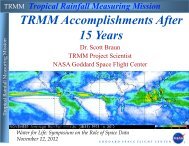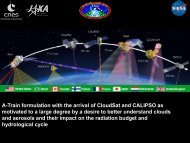The mission of ALOS-2
The mission of ALOS-2
The mission of ALOS-2
Create successful ePaper yourself
Turn your PDF publications into a flip-book with our unique Google optimized e-Paper software.
<strong>The</strong> Current Status and Brief Results <strong>of</strong><br />
Engineering Model for PALSAR-2 onboard <strong>ALOS</strong>-2<br />
and Science Project<br />
+<br />
<strong>The</strong> 16 th KC meeting<br />
Japan Aerospace Exploration Agency<br />
Masanobu Shimada, Yukihiro KANKAKU
<strong>The</strong> <strong>mission</strong> <strong>of</strong> <strong>ALOS</strong>-2<br />
• Advanced Land Observing Satellite-2(<strong>ALOS</strong>-2) is the post <strong>ALOS</strong><br />
PALSAR <strong>mission</strong> (PALSAR is the L-band SAR onboard <strong>ALOS</strong> )<br />
• <strong>ALOS</strong>-2 is an L-band SAR (PALSAR-2) satellite planned to be<br />
launched in 2013<br />
• <strong>The</strong> main objection <strong>of</strong> <strong>ALOS</strong>-2 is as follows,<br />
– Land management<br />
– Resource management<br />
– Resource exploration<br />
– Disaster monitoring<br />
• In order to meet the requirements, <strong>ALOS</strong>-2 observes higher<br />
resolution, better sensitivity and higher image quality than PALSAR.<br />
2
<strong>The</strong> overview <strong>of</strong> <strong>ALOS</strong>-2<br />
<strong>ALOS</strong>‐2 satellite parameters<br />
Orbit type : Sun‐synchronous<br />
Launch : 2013<br />
Altitude : 628km +/‐ 500m(for reference orbit)<br />
Revisit time : 14days<br />
LSDN : 12:00 +/‐ 15min<br />
SAR antenna<br />
Z<br />
Y<br />
X<br />
PALSAR‐2 (Mission Sensor)<br />
L‐band Synthetic Aperture Radar<br />
Active Phased Array Antenna type<br />
two dimensions scan (range and azimuth)<br />
Antenna size : 3m(El) x 10m(Az)<br />
Bandwidth : 14 to 84MHz<br />
Peak transmit Power : 5100W<br />
Observation swath : 25km to 490km<br />
Resolution : Range 3m to 100m<br />
Azimuth 1m to 100m<br />
3
Specification <strong>of</strong> PALSAR-2<br />
Spotlight Ultra Fine<br />
High<br />
sensitive<br />
Fine<br />
ScanSAR<br />
nominal<br />
ScanSAR<br />
wide<br />
Bandwidth 84MHz 84MHz 42MHz 28MHz 14MHz 28MHz 14MHz<br />
Resolution<br />
Rg×Az:<br />
3×1m<br />
3m 6m 10m 100m 60m<br />
Swath<br />
Rg×Az:<br />
25×25km<br />
50km 50km 70km<br />
350km<br />
5scan<br />
490km<br />
7can<br />
Polarization SP SP/DP SP/DP/FP/CP SP/DP<br />
NESZ -24dB -24dB -28dB -26dB -26dB -23dB -23dB<br />
S/A<br />
Rg<br />
Az<br />
25dB<br />
20dB<br />
25dB<br />
25dB<br />
23dB<br />
20dB<br />
25dB<br />
23dB<br />
25dB<br />
20dB<br />
20dB<br />
20dB<br />
SP : HH or VV or HV , DP : HH+HV or VV+VH , FP : HH+HV+VH+VV , CP : Compact pol (Experimental mode)<br />
<strong>The</strong> each observation mode will be used for ...<br />
Spotlight : Emergency Observation<br />
Ultra Fine : nominal observation to collect the basemap for InSAR.<br />
High sensitive : flood observation.<br />
Fine : same as PALSAR observation.<br />
ScanSAR nominal (28MHz bandwidth) : ScanSAR-ScanSAR InSAR.<br />
ScanSAR wide : ship detection.<br />
4
New techniques<br />
• High power and efficiency device<br />
– to get high quality image (better NESZ)<br />
– GaN HEMT ⇒ the first flight for satellite in the world.<br />
• Dual receive antenna system<br />
– to get wide swath (low PRF)<br />
– SAR antenna is consisted from 5 electric panel.<br />
– full aperture for trans<strong>mission</strong> and divided antenna for receiving<br />
• Chirp modulation<br />
– to get high quality image (better S/A)<br />
– Up/Down and Phase modulation to distinguish the pulses<br />
• New data compression algorithm<br />
– updated BAQ algorythm<br />
5
3m<br />
<strong>The</strong> Engineering Models<br />
• <strong>The</strong> antenna Engineering Model (EM)<br />
– the size for antenna EM is half <strong>of</strong> one electric panel.<br />
elliptical aperture : to reduce the sidelobe<br />
①<br />
②<br />
10m<br />
③<br />
④<br />
⑤<br />
<strong>The</strong> structure is one electric panel size,<br />
however the only half quantity <strong>of</strong> antenna radiation elements are mounted.<br />
6
<strong>The</strong> Engineering Models<br />
• <strong>The</strong> interface between antenna elements and the components<br />
mounted on antenna was confirmed.<br />
– mounted components are trans<strong>mission</strong> and receive module(TRM),<br />
power supply for TRM(MPSU) and controll unit (CDU) etc.<br />
• <strong>The</strong> analized radiation antenna pattern using EM <strong>of</strong> antenna<br />
elements was good result,<br />
EL 30deg stterubg Az 3.5 deg stterubg<br />
• <strong>The</strong> realistic radiation antenna pattern (antenna EM size) will be<br />
measured in this week.<br />
7
• <strong>The</strong> Critical Design Review for <strong>ALOS</strong>-2 was completer last week.<br />
• <strong>The</strong> Proto Fright models will be manufactured.<br />
Calendar<br />
Year<br />
Milestone<br />
<strong>ALOS</strong>-2<br />
<strong>The</strong> future schedule<br />
2008 2009 2010 2011 2012 2013<br />
SDR PDR CDR<br />
Phase-B<br />
Phase-C Phase-D<br />
28 th ISTS<br />
Launch<br />
8
CAL/VAL: Calibration <strong>of</strong> PALSAR-2<br />
SAR imaging and applications (Sigma-SAR update)<br />
High level product (Ortho, Slope, InSAR-DEM)<br />
Application:<br />
Forest monitoring (REDD+, Illegal Logging)<br />
Disaster monitoring (DinSAR, Change Detection, Oil spill,<br />
subsidence, earthquake, volcano)<br />
Wind speed measurements (Coastal field)<br />
Ionospheric monitoring<br />
Cryospheric observation<br />
Coastal line observation<br />
RA programs (RA-4, July 2012, Node is not available)
Schedule<br />
L+0~L+2: Initial Check(i.e., launch Aug<br />
2013)<br />
L+2~L+5: Initial Calibration<br />
L+5~ : Operation Start (i.e.,<br />
Jan. 2014)
Conclusion<br />
•<strong>ALOS</strong>-2 in preparation for 2013 launch.<br />
•<strong>ALOS</strong>-2 CDR has been successfully<br />
conducted on June 2 2011.<br />
•Basic observation Plan needs to be<br />
prepared. Collaboration with InSAR<br />
research groups and REDD+ users.<br />
•L1.1 or higher is the main products for<br />
distribution.


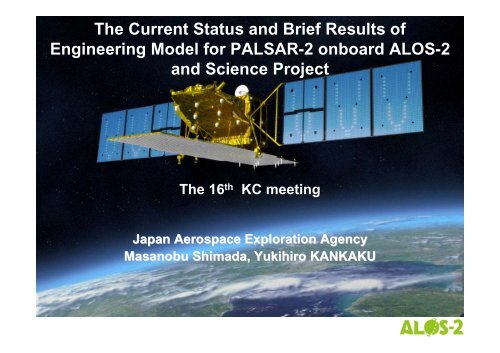
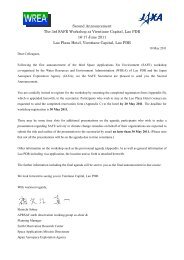
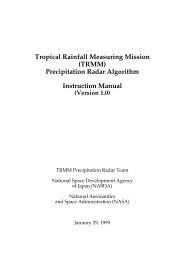


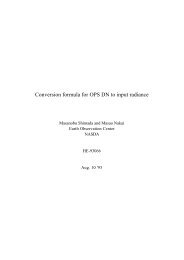
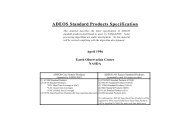
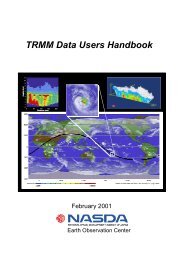
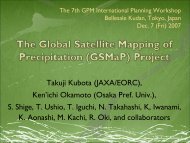
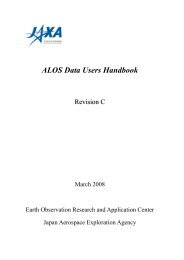
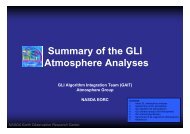
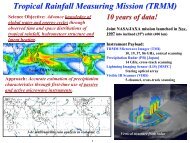
![4.12.2a_Tibet_Wu Guoxiong Tibet-CEOP.ppt[]](https://img.yumpu.com/35802437/1/190x135/4122a-tibet-wu-guoxiong-tibet-ceopppt.jpg?quality=85)
